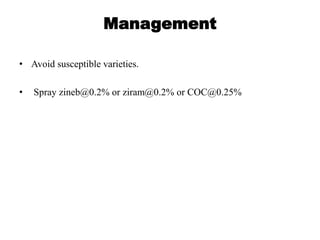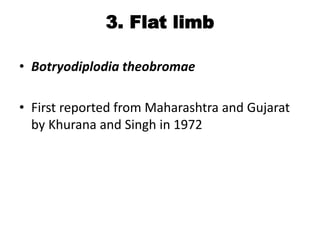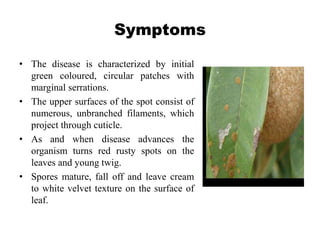Diseases of Sapota
- 2. 1. Leaf spot / Phavophleospora leaf spot • Phaeopleospora indica: Initially circular spots pinkish in colour appear which gradually turn brownish in colour. • Centre of the spot is whitish grey coloured and number of spots are more on leaves.
- 3. Management • Avoid susceptible varieties. • Spray zineb@0.2% or ziram@0.2% or COC@0.25%
- 4. 2. Pestalotiopsis leaf spot • Pestalotiopsis versicolor (Syn: Pestalotia versicolor, P. sapotae and P. podocarpi)
- 5. Symptoms • Small, reddish brown specks on leaf lamina. • Spots enlarge, become circular measuring 1 to 3 mm in diameter • Fully developed spots show grayish centre and dark brown to reddish margin • Minute black fruiting bodies (pycnidia) are seen in the center of spots
- 6. 3. Flat limb • Botryodiplodia theobromae • First reported from Maharashtra and Gujarat by Khurana and Singh in 1972
- 7. Symptoms • Branches of affected trees become flat and twisted. • Leaves become thin, small and yellow. • Cluster of leaves and flowers on affected twigs. • Flowers remain infertile. • If fruits are set, they are undersized, hard and fail to ripen. • Foliage and fruits fall prematurely.
- 8. 4. Sooty mould • Capnodium versicolor
- 9. Symptoms • Disease severity increases in increased population of leaf hoppers, aphids and other insects. • Black superficial growth on entire surface of leaves, fruits and twigs. • Fungus is not a parasite. It grows on the excreta and honey secretions of insects. • Under dry spell such affected leaves curl & shrivel. During flowering time the appearance of the disease results in reduced fruit set. • Sooty mass is a superficial growth of the fungus and it multiplies on insect secretions. Impact of this disease on host is photosynthesis activity and yield decreases.
- 10. Mode of spread • Primary source of inoculum: Dormant mycelia • Secondary source of inoculum: Air borne conidia: Spread: Insects, Aphids, wind. Epidemiology: • Temperature 28-32 ⁰C, 85-90% RH, Warm Weather and susceptible host.
- 11. Management • Sprays of wettable sulphur 0.2% along with insecticide Dimethoate 1.5g/lit • Spray of 1% starch solution makes flakes of the fungus and due to small wind falls of from the plant.
- 12. 5. Red rust • Cephaleuros versicolor. • The algal disease and it has been observed in India and else where. It is one of the minor disease of importance. • Reduction in photosynthetic activity and defoliation as a result of algal attack lower vitality of the host plant.
- 13. Symptoms • The disease is characterized by initial green coloured, circular patches with marginal serrations. • The upper surfaces of the spot consist of numerous, unbranched filaments, which project through cuticle. • As and when disease advances the organism turns red rusty spots on the leaves and young twig. • Spores mature, fall off and leave cream to white velvet texture on the surface of leaf.
- 14. Epidemiology • The disease is more common on close plantation. • The zoospores cause initial infection. • High moist condition favours development of fruiting bodies of the algae. Management: • it is controlled by spraying with Bordeaux mixture 1% or Copper Oxychloride 0.3% or lime sulphur 0.2%.













